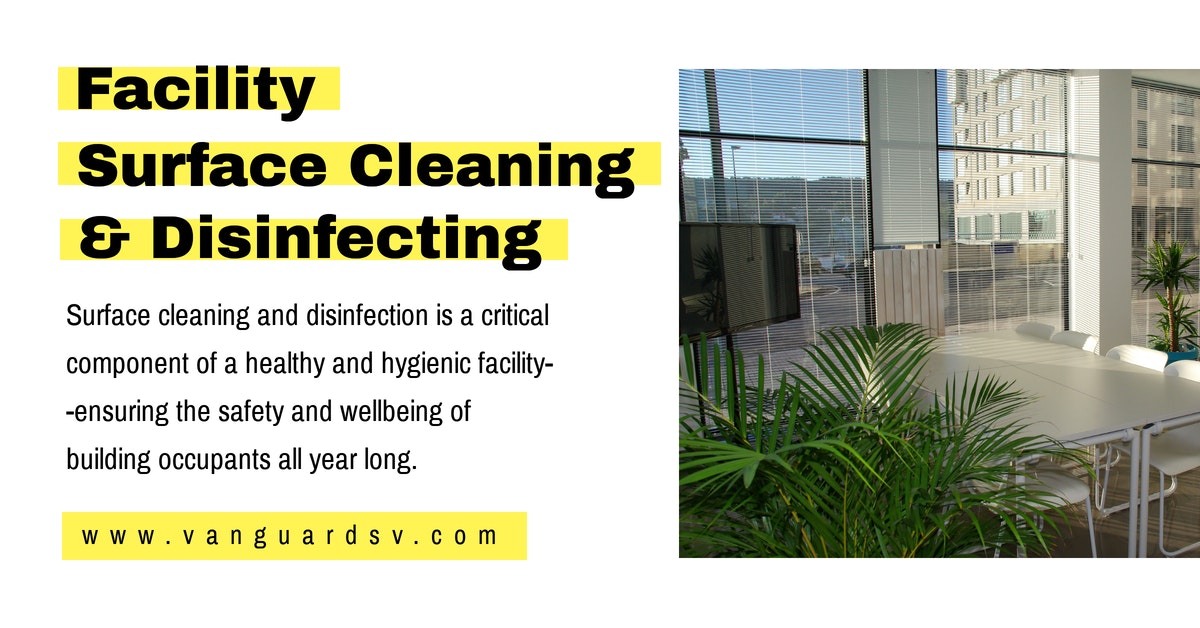Surface cleaning and disinfection is a critical component of a healthy and hygienic facility--ensuring the safety and wellbeing of building occupants all year long.

The Importance of Surface Cleaning and Disinfecting All Year Long
If one lesson can be taken away from the past few weeks, it is that we have been lax in our hygiene and the cleanliness of the facilities we regularly occupy.
Nearly all infectious diseases are transmitted via touch--even, or perhaps especially, airborne viruses, which can reside and remain active for days on the surfaces we routinely touch each day.
According to the CDC, about 80% of infectious diseases are spread by touch -- the cold germs get on the hands and from there into the eyes and mouth.
Why does this matter?
- Between 23,000 and 59,000 people have died from the flu or flu-like illness this year.
- Norovirus kills approximately 200,000 people worldwide each year.
- Proper handwashing--just in airports--could significantly reduce the risk of a global pandemic.
According to a recent article published by EurekAlert;
A study published in Risk Analysis analyzes the impact of implementing disease mitigation strategies at airports across the globe.
The study finds that increasing traveler engagement with proper hand-hygiene at all airports has the potential to reduce the risk of a potential pandemic by 24-69 percent.
The researchers also identified ten critical airports, central to the global air-transportation network, and if hand-washing mitigation strategies are implemented in just these ten locations, the pandemic risk can drop by up to 37 percent.
Study shows increased hand hygiene at top 10 airports can reduce spread of coronavirus by 37 percent
Second in importance to hand hygiene is regular old cleaning with soap and water.
According to a recent article published in The Guardian;
So why does soap work so well on the Sars-CoV-2, the coronavirus and indeed most viruses?
The short story: because the virus is a self-assembled nanoparticle in which the weakest link is the lipid (fatty) bilayer.
Soap dissolves the fat membrane and the virus falls apart like a house of cards and dies – or rather, we should say it becomes inactive as viruses aren’t really alive.
Soap contains fat-like substances known as amphiphiles, some of which are structurally very similar to the lipids in the virus membrane.
The soap molecules “compete” with the lipids in the virus membrane.
This is more or less how soap also removes normal dirt from the skin.
The soap not only loosens the “glue” between the virus and the skin but also the Velcro-like interactions that hold the proteins, lipids and RNA in the virus together.
The last part is touchpoint disinfection, which involves the identification and routine cleaning and disinfection of high-contact germ hot spots throughout your facility.
The most common of which include:
- Door handles.
- Light switches.
- Handrails.
- Elevator buttons.
- Phones.
- Sinks and faucets.
- Restroom stalls and dispensers.
- Vending machines.
- Food preparation surfaces and countertops.
- Tables, desks, and chairs.
- Microwave, refrigerator, and kitchen appliance handles.
- Coffee machines.
- Copier, printer, and fax control buttons.
- Cabinet and file drawer handles, and;
- Computer keyboards and mice.
Source:
How to Properly Clean and Disinfect Facility Surfaces
Always clean before disinfecting--doing otherwise will reduce the efficacy of the disinfectant.
Read the labels of the products that you're using to make sure you understand how to use them safely and effectively.
Wear the appropriate safety equipment, specifically disposable gloves, especially when cleaning during cold and flu season.
After cleaning with water and detergent or soap, apply the disinfectant.
If you're unsure of what kind of disinfectant to use in your facility--depending on the type of facility you're cleaning--you can dilute 1/3 cup bleach per gallon of water.
Wait the specified laytime--typically 10 minutes--and then wipe down the surfaces with a microfiber towel to remove any residue leftover from the disinfectant.
Safely dispose of any used water, cleaning product, and disposable safety equipment, then wash your hands and make sure to launder your clothes separately.
For More Information:
Takeaway
The stark reality is that an outbreak--be that influenza, rhinovirus, norovirus, or coronavirus--can happen at any time, and each of these viruses typically has a peak activity period throughout the year.
As opposed to causing us to lock ourselves away in fear, we must instead address the lapses we have allowed to occur in our personal hygiene, as well as the way we use and clean the facilities we occupy.
Germs have been and will remain an everyday part of our lives, and we can control their impact on our health and wellbeing without destroying our immune system or environment through the application of environmentally preferable cleaning products combined with a clean for health first approach.
If you would like more information regarding the effectiveness of high-performance infection prevention and control measures, or if you would like to schedule a free, no-obligation onsite assessment of your facility's custodial needs, contact us today for a free quote!
In Bakersfield CA, call (661) 437-3253
In Fresno CA, call (559) 206-1059
In Valencia CA, or Santa Clarita CA, call (661) 437-3253
In Palmdale CA, or Lancaster CA, call (661) 371-4756

